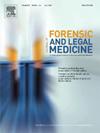Assessing the importance of post-mortem interval and other variables on the analysis of ethanol in the vitreous humour with a focus on ethyl glucuronide and ethyl sulfate: A critical review
IF 1.2
4区 医学
Q3 MEDICINE, LEGAL
引用次数: 0
Abstract
Vitreous humour is used to assess intoxication at the time of death due to its anatomical isolation, which reduces contamination risk. Toxicological analysis typically includes drugs and alcohol. For interpreting post-mortem ethanol concentrations, distinguishing between ante-mortem ingestion and post-mortem production from putrefaction is essential. For this purpose, biomarkers like ethyl glucuronide (EtG) and ethyl sulfate (EtS) are crucial for confirming alcohol consumption.
Factors such as post-mortem interval (PMI), the cause of death, individual characteristics like sex, age, body mass index (BMI), ambient temperature at corpse discovery, and body storage temperature may affect vitreous humour analysis. The present review explores how these factors have been integrated into the current scientific discussion on the quantification of ethanol, EtG and EtS in vitreous humour, and how they ultimately impact the determination of the cause of death.
Our findings indicate that the PMI is often unspecified in reviewed cases (64 %), and when mentioned, it is under 24 h (17 %). Individual characteristics like sex, age, and BMI are frequently omitted (43 %, 46 %, and 86 %, respectively), and details on ambient and storage temperatures are rarely provided. Although post-mortem alterations in ocular anatomy are well-documented, there are limited studies that report ethanol stability in vitreous humour across various PMIs. For EtG and EtS, no studies have evaluated quantitative changes in vitreous humour in relation to PMI. Despite these data gaps, available studies suggest that age and BMI may influence the analysis of ethanol in cases of alcohol-related deaths, underscoring the need for further research on factors affecting substance levels in vitreous humour.
评估死亡间隔和其他变量对玻璃体中乙醇分析的重要性,重点是葡萄糖醛酸乙酯和硫酸乙酯:一项重要综述
玻璃体幽默在死亡时被用来评估中毒,因为它在解剖上是隔离的,这降低了污染的风险。毒理学分析通常包括药物和酒精。为了解释死后的乙醇浓度,区分死前摄入和死后腐烂产生的乙醇是至关重要的。为此,葡萄糖醛酸乙酯(EtG)和硫酸乙酯(EtS)等生物标志物对于确认饮酒至关重要。诸如死后间隔(PMI)、死因、个体特征如性别、年龄、体重指数(BMI)、发现尸体时的环境温度和尸体储存温度等因素可能影响玻璃体幽默分析。本综述探讨了这些因素如何被整合到目前关于玻璃体幽默中乙醇、EtG和et定量的科学讨论中,以及它们最终如何影响死因的确定。我们的研究结果表明,在审查的病例中,PMI通常不明确(64%),当提及时,它在24小时内(17%)。个体特征如性别、年龄和身体质量指数经常被忽略(分别为43%、46%和86%),环境温度和储存温度的细节也很少被提供。尽管死后眼解剖结构的改变有充分的文献记载,但报告乙醇在各种PMIs玻璃体幽默中的稳定性的研究有限。对于EtG和EtS,没有研究评估玻璃体幽默与PMI相关的定量变化。尽管存在这些数据缺口,但现有研究表明,年龄和BMI可能会影响酒精相关死亡病例中乙醇的分析,这强调了对玻璃体幽默中影响物质水平的因素进行进一步研究的必要性。
本文章由计算机程序翻译,如有差异,请以英文原文为准。
求助全文
约1分钟内获得全文
求助全文
来源期刊

Journal of forensic and legal medicine
MEDICINE, LEGAL-
CiteScore
2.70
自引率
6.70%
发文量
106
审稿时长
57 days
期刊介绍:
The Journal of Forensic and Legal Medicine publishes topical articles on aspects of forensic and legal medicine. Specifically the Journal supports research that explores the medical principles of care and forensic assessment of individuals, whether adult or child, in contact with the judicial system. It is a fully peer-review hybrid journal with a broad international perspective.
The Journal accepts submissions of original research, review articles, and pertinent case studies, editorials, and commentaries in relevant areas of Forensic and Legal Medicine, Context of Practice, and Education and Training.
The Journal adheres to strict publication ethical guidelines, and actively supports a culture of inclusive and representative publication.
 求助内容:
求助内容: 应助结果提醒方式:
应助结果提醒方式:


